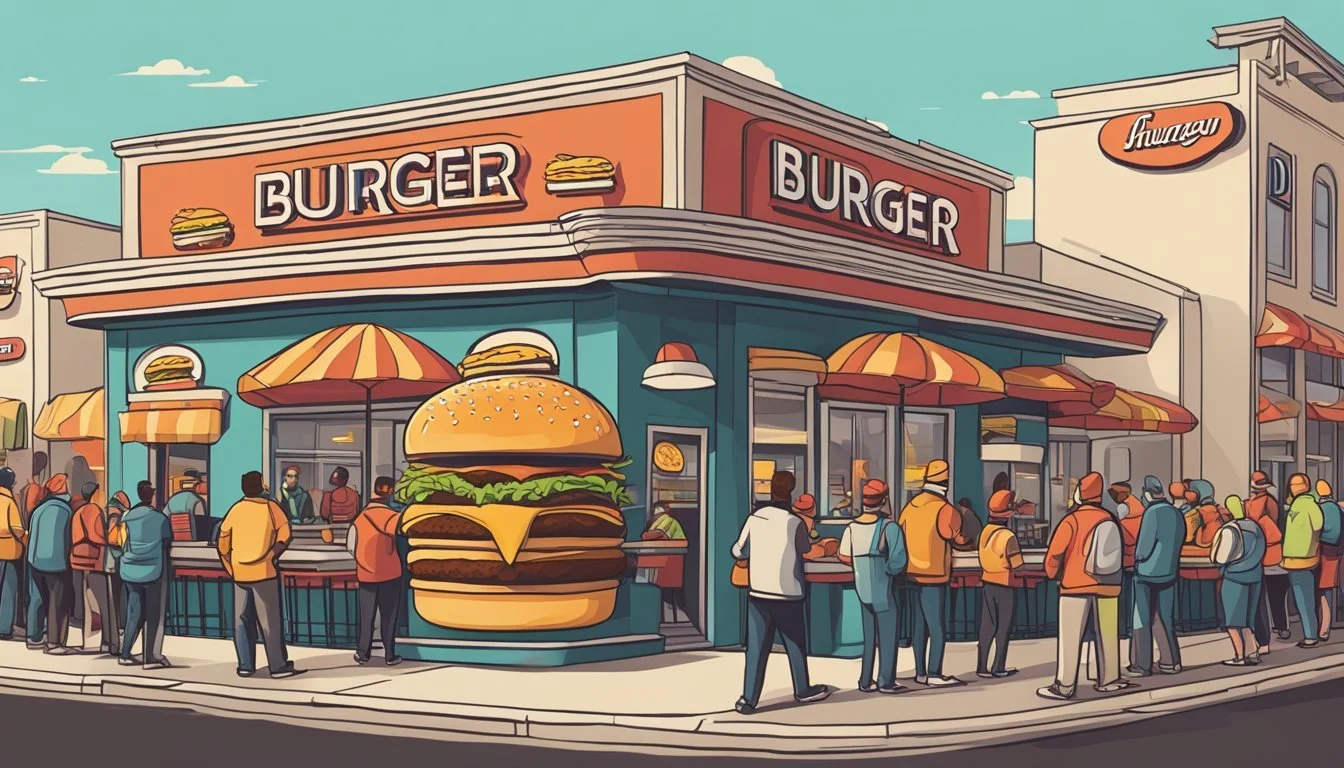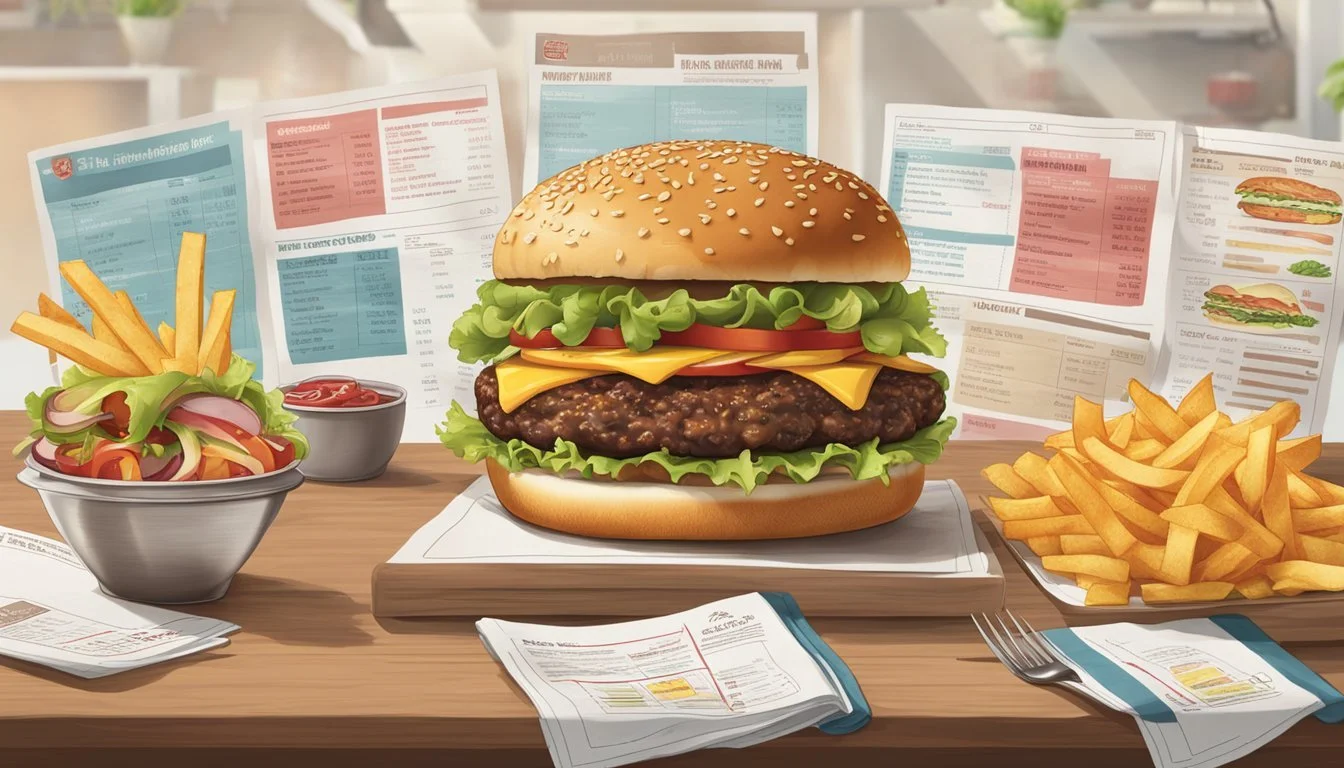Carl's Jr. vs Smashburger
A Comprehensive Comparison of Burger Quality and Taste
When seeking a satisfying burger experience, patrons often find themselves at the crossroads of choice between popular burger joints like Carl's Jr. and Smashburger. These two establishments serve a crowd that craves juicy hamburgers and cheeseburgers, each with its own unique approach to satisfying fast food aficionados. Carl's Jr., known for its bold flavors and innovative creations, sits confidently in the market as a place that's not afraid to push the boundaries of what a fast food burger can be. On the flip side, Smashburger has built its reputation on a 'smash' cooking method that aims to intensify flavor and create a well-caramelized crust, making their offerings stand out.
With a culinary landscape that is as diverse as the American palate, Carl's Jr. and Smashburger have both found their niches. The former often incorporates American cheese and a variety of other toppings to cater to a wide range of tastes, while the latter emphasizes its method of crafting the patty as a key component of flavor. While Carl's Jr. tends to focus on big, bold burgers with heavy toppings and sauce, Smashburger's philosophy leans towards simplicity and the highlighting of the quality of the meat.
The question of which burger joint is better is more complex than it might initially appear, dependent on individual preference for burger composition and taste. Consumers look for different qualities in their burger experience—some prioritize innovative flavors and generous portions, while others might place the highest value on the textures and the quality of ingredients. When comparing Carl's Jr. and Smashburger, it becomes a matter of weighing these factors and deciding which aligns better with one's personal burger values.
Brand History and Evolution
The histories of Carl's Jr. and Smashburger are rooted in American culture, reflecting the nation's love for burgers. Both chains have unique origins and have seen significant expansion over the years.
Carl's Jr. Foundations and Growth
Carl's Jr. began its journey in 1941 when founder Carl Karcher opened a hot dog cart in Los Angeles, California. Selling 10-cent hot dogs, tamales, and chili dogs, Karcher's initial business was humble, but it set the stage for a future fast-food empire. Over time, Carl's Jr. evolved from a hot dog stand into a well-known fast-food burger chain. The brand's growth can be attributed to its focus on innovative menu items and effective marketing strategies. Evolving from a symbol of small-scale entrepreneurship to a major corporate presence, Carl's Jr. became a staple in America's fast-food landscape.
Smashburger's Beginnings and Expansion
In contrast, Smashburger entered the burger scene much later, with its history starting in 2007. Founded in Denver, Colorado, Smashburger quickly established itself by offering a "better burger" experience with a unique method of smashing the beef patty on the grill. This technique ensures juicy, flavorful burgers with every bite. Despite being a young company compared to Carl's Jr., Smashburger has expanded rapidly, both domestically and internationally, presenting a fresh challenge to established brands with its focus on high-quality ingredients and innovative menu offerings.
Menu Comparison
Comparing Carl's Jr. and Smashburger, one finds distinctive differences in their offerings, from the signature burgers to the range of sides and healthier alternatives. Each restaurant brings its own unique flair to the classic American fast food experience.
Burgers and Signature Offerings
Carl's Jr. is renowned for their Thickburgers, like the Western Bacon Cheeseburger and the Big Carl. They emphasize their charbroiled approach, touting never-frozen beef patties. Smashburger counters with its namesake Smashburger, a burger pressed and seared for flavor, and also features the crowd-favorite Classic Smash.
Carl's Jr.:
Thick, charbroiled patties
Signature: Western Bacon Cheeseburger, Big Carl
Smashburger:
Smashed and seared patties
Signature: Classic Smash
Variety of Sides and Alternatives
The side menus at these chains bring a variety of tastes to complement their burgers. Carl's Jr. serves traditional sides like fries and onion rings but also offers alternatives such as fried zucchini. Smashburger also offers fries, with the option of tossing them in rosemary, garlic, and olive oil for a unique flavor.
Carl's Jr.:
Traditional sides: Fries, Onion rings
Alternatives: Fried zucchini
Smashburger:
Fries (option: rosemary, garlic, olive oil)
Vegetarian and Healthier Options
In response to the rising demand for vegetarian and health-conscious choices, both chains have expanded their menu. Carl's Jr. features the Beyond Burger, a plant-based option. Smashburger serves the Black Bean Burger for vegetarians. Concerning calories, both strive to provide information to help patrons make healthier choices.
Carl's Jr.:
Plant-based: Beyond Burger
Calories listed for all items
Smashburger:
Vegetarian: Black Bean Burger
Nutritional information available
Customer Experience and Service
In the fast-paced landscape of fast food, Carl's Jr. and Smashburger are constantly vying for customer loyalty through their in-restaurant experience and service quality.
Dining Ambiance
Carl's Jr. presents a laid-back, drive-in barbecue atmosphere which appeals to those seeking a casual dining experience. It's known for its quick service model that doesn't sacrifice a welcoming sit-down feel. With its iconic star logo and traditionally larger seats, the environment at Carl's Jr. is typically comfortable for families and individuals who want to enjoy their meals without a rush.
In contrast, Smashburger takes pride in a more modern and polished interior that matches its approach to providing a 'better burger' experience. Its spaces often adopt an open kitchen design, allowing customers to witness their food being prepared, which adds a level of transparency and engagement to the dining experience. The ambiance at Smashburger tends to aim for a blend of fast food speed with a touch of fast-casual sophistication.
Service Efficiency and Friendliness
When it comes to service efficiency, both burger joints prioritize swift order fulfillment, recognizing that value is often measured in time as much as taste. Carl's Jr. has historically benefited from a drive-thru system, focusing on delivering orders accurately and rapidly so that customers can enjoy their food while on the go. The integration of recent technologies has played a role in maintaining this efficiency.
Smashburger trains its staff to not just serve quickly, but to also provide personalized service. They often engage more with customers, taking time to explain the menu or suggest customizations. Despite this approach requiring a bit more time, it reflects their commitment to customer satisfaction, balancing the urgency of fast food with the attentiveness of sit-down service.
Each brand applies its own philosophy to customer service, understanding that the perceived value of their offerings is as much a product of the experience as it is the food.
Pricing and Value for Money
When considering Carl's Jr. and Smashburger, the evaluation of pricing and the value each brand provides is essential. Carl's Jr. boasts a comprehensive menu with a price range that caters to both budget-friendly and premium options. For instance, a basic burger can start at around $3.99, while more elaborate offerings such as the Teriyaki Burger or The Big Carl hover around the $6.49 price point.
Smashburger, on the other hand, delineates itself with its Classic Smash burger, priced at $6.99. This burger is accompanied by a certified Angus beef patty and conventional toppings. Their price reflects a firm commitment to quality ingredients, aligning with their fast-casual dining experience.
When contrasting both establishments to competitors like McDonald’s, Burger King, Wendy’s, and Five Guys, it becomes apparent that these brands position themselves between the conventional fast food and the upscale burger experiences. Five Guys, particularly, has influenced the market with its upscaled approach, making the transition from fast food to fast casual, which is mirrored in Smashburger's operational style and pricing strategy.
In terms of overall value, one must weigh not just cost, but the quality and size of the burger, the ambiance of the dining experience, and customer satisfaction. Neither Carl's Jr. nor Smashburger positions themselves as the cheapest option on the market, but they both strive to offer a better burger that justifies a slightly higher price tag compared to industry giants like McDonald’s and Burger King. As for which holds the title for the best burger, this remains subjective and often depends on individual preference and taste.
Marketing and Brand Image
When considering the marketing and brand image of Carl's Jr. and Smashburger, the strategies these burger chains employ play a crucial role. These approaches directly affect their social presence, consumer perceptions, and ultimately, their market share against competitors like McDonald's, Burger King, and Wendy's.
Advertising Strategies
Carl's Jr. has historically adopted bold advertising strategies that often generated buzz and controversy. They have since shifted from ads that focused on sex appeal to more food-centric marketing, highlighting the quality and taste of their burgers. This change is reflective of a broader industry trend towards emphasizing product quality in marketing.
Smashburger, on the other hand, has leveraged the popularity of the "smashed patty" cooking technique. The brand places its focus on the distinctive flavor achieved through this method, thereby gaining recognition for culinary innovation in a crowded marketplace.
Carl's Jr.:
Previous use of sexualized imagery
Current focus on burger quality
Smashburger:
Highlighting unique cooking technique
Associating brand with culinary innovation
Social Presence and Reputation
Smashburger maintains a solid social media presence and is known for engaging with customers through platforms like Twitter and Facebook. They also employ targeted marketing campaigns and promotional deals to enhance their reputation as a consumer-friendly brand.
In comparison, Carl's Jr. has worked to revitalize its image, shifting its reputation from one associated with controversial marketing to one that underscores a commitment to quality and innovation. Their efforts in digital enhancements and consumer-focused advertising reflect a modern, revamped brand image.
Carl's Jr.:
Improved digital engagement
Repositioned brand image focusing on innovation
Smashburger:
Active engagement on social media
Reputation bolstered by customer interaction and promotions
Nutritional Information and Quality
When it comes to nutritional information, both Carl's Jr. and Smashburger present options that can be higher in calories and fat, a common characteristic of fast food burgers. Carl's Jr. offers burgers like "The Really Big Carl," containing 930 calories and 58g of fat, indicative of a more indulgent choice.
In contrast, Smashburger's menu includes the "Classic Smash Burger," which is 540 calories with 31g of fat. While lower in calories than Carl's Jr's big-name burger, it is still rich in flavor, often described as fresh and juicy.
Protein content is a significant focus for those looking at muscle building or satiety. Smashburger's Classic option delivers a substantial 27g of protein, and although Carl's Jr. does not reveal protein in the snippet, their burgers traditionally carry a high protein amount as well.
Neither establishment advertises burgers as "never frozen," which competing chains like Wendy's highlight as a point of quality. Wendy’s emphasizes the use of fresh, never-frozen beef, a tactic that communicates a commitment to quality that informed consumers may look for in nutritional debates.
It's important for consumers to discern that while higher calorie content may not align with certain dietary goals, it does not necessarily reflect the overall quality or taste of the burger. Both Carl's Jr. and Smashburger have their own approaches to providing satisfying burgers, leaving patrons to consider the balance between nutritional content and indulgent taste.
Regional Variations and Global Presence
In considering Carl's Jr. and Smashburger, it's insightful to look into how they cater to regional tastes within the U.S. and their approaches to international markets.
U.S. East vs. West Coast Offerings
On the East Coast, particularly in states like New York, Carl's Jr. is conspicuous by its absence, making room for the aggressive expansion of chains such as Smashburger, who adapt their menus to the local flavors preferred by Easterners. Conversely, on the West Coast, Carl's Jr. has a strong foothold, especially in its home state of California, offering menu items that appeal to the West Coast palate, such as the California Classic Double Cheeseburger.
Carl's Jr.:
Popular in the West, with a menu featuring items that incorporate fresh avocados and Cali-Mex flavors.
Smashburger:
Growing presence in the East, with offerings that might include more urban, artisanal options to appeal to diverse metropolitan tastes.
International Expansion and Menu Differences
Carl's Jr. has established a significant global presence, expanding into over 40 countries, with plans to enter Peru, marking their 41st. This international chain often adapts its menu to local tastes, which can mean inclusion of localized ingredients or unique burger creations that cater to the regional palate.
Smashburger is focusing on domestic growth and international opportunities. While Smashburger is also known for its customizable offerings, it has yet to match the global reach of Carl's Jr., although it's making strides towards establishing itself internationally, with a strategic approach that's yet to be disclosed in detail.
International Menu Examples:
Carl's Jr. may offer teriyaki burgers in Japan or jalapeño burgers in Mexico to respect local culinary preferences.
Smashburger's international menu adaptations remain less documented, but similar strategies are likely as the brand expands.
Consumer Reviews and Ratings
When it comes to comparing Carl's Jr. and Smashburger, consumer reviews and ratings are insightful for discerning the preferences of the general public.
Carl's Jr.:
Yelp: On average, Carl’s Jr. locations have ratings that range from 2 to 4 stars. Standout compliments often highlight the Super Star with Cheese burger and the variety of options available.
Google Reviews: Reviewers on Google are similarly mixed, with an overall trend of 3 to 4 stars. Consistent praise is noted for their thick tomato slices and charbroiled patties.
Smashburger:
Yelp: Smashburger receives a more consistent rating of 3 to 4.5 stars on Yelp. Consumers seem to appreciate the brand's focus on quality and the flavorful aspect of their Classic Smash burger.
Google Reviews: Google ratings echo Yelp's sentiment, with many locations averaging around 4 stars. The smashed patties and the attention to the Maillard reaction for taste are frequently mentioned.
Comparative Pointers:
Service Speed: Reviews often mention that Carl's Jr. provides quick service, which is an expected feature in fast-food joints. Smashburger, recognized for quality over speed, trends slightly lower in this area.
Customer Service: Both burger joints receive mixed feedback on customer service, affecting their overall rating.
Atmosphere: Smashburger is generally described as having a pleasant and modern atmosphere in its locations, whereas Carl's Jr. reviews are more variable in this regard.
Consumers appear to differentiate these establishments not just by their burgers, but also by their overall experiences. It's clear from reviewing consumer feedback that personal taste and what one values in a burger joint play significant roles in these ratings.
Conclusion and Final Verdict
When comparing Carl's Jr. and Smashburger, the decision on the best burger joint is influenced by individual preference regarding flavors and dining experience.
Carl's Jr.:
Offers a range of charbroiled burgers, renowned for their bold flavors and size.
Known for innovative and indulgent offerings.
Provides a drive-thru, catering to diners seeking convenience.
Smashburger:
Stands out with its signature smashing technique, ensuring a seared and savory flavor profile.
Focuses on certified Angus beef in their burgers emphasizing quality.
Arguably appeals to patrons preferring a "gourmet" burger experience.
Both burger joints propose a unique take on the classic American burger. Smashburger earns points for quality and specific cooking technique, which might be perceived as superior by some customers, while Carl's Jr. scores for hearty, indulgent options that cater to a wider audience with its convenience-oriented services. Each brand has cultivated a loyal following and offers notable menu items that appeal to different tastes.
Those prioritizing a fast-casual ambiance with an emphasis on beef quality might lean towards Smashburger. In contrast, individuals who enjoy a varied menu with the ease of a drive-thru may favor Carl's Jr. It must be said that at either establishment, burger enthusiasts can find a satisfying burger that caters to their palette.






